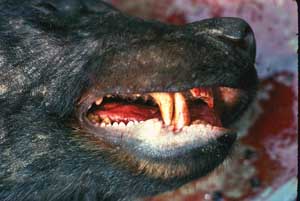|
|
 3 canines DHJanzen100916.jpg high resolution
|
|
|
Compare this image with image DHJanzen100917.jpg below, and note that the lower canine tooth is positioned in front of the upper canine tooth. Note that there is even a space for its tip to fit between the base of the upper canine and the incisors. The lower canines very nicely lock against the upper canine so that the lower jaw cannot shift backward. Why? So that when the bear is biting down on a bone (or other hard object) with its molars, a motion that pulls the lower jaw backward (because the muscles the pull the lower jaw upward are attached more posteriorily on the skull (see skull below in image DHJanzen100920.jpg), the lower jaw does not dislocate where from the socket where it fits with the skull. Think about that time that you put a large carrot between your rearmost molars and bit down hard, and the socket (condyle) where your jaw joins your skull really hurt. Interestingly, the pig and peccary, both animals that break hard nuts with their molars, have also evolutionarily invented this positioning of the lower canines in front of the uppers (for the same reason as in the bear). Second, note that the diastema - the toothless open space between the canines and the molars - has something in it. Not teeth, but something. Those tough high bumps on the lower and upper lips, looking from the side much like many small teeth, are in fact soft and evergrowing (replaceable) lip tissue used like so many fingers to strip berries off of branches (see image DHJanzen100939.jpg below), branches that would wear down the teeth if they were used for this. |
||
back to lecture slides
or skip to: